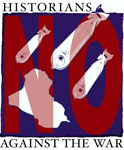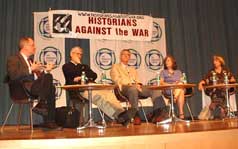
August 29, 2004: This Is What History Looks Like
 August 29, 2004: This Is What History Looks Like
August 29, 2004: This Is What History Looks Like
By Van Gosse
Nothing like it has happened in the 170 years since American political parties began meeting in convention to choose their presidential candidates. Half-a-million people marched for six hours in broiling summer heat to repudiate a sitting president at the moment and place of his triumphal renomination. Now the urgent question becomes: How can this huge new antiwar movement, led by the United for Peace and Justice, engage with practical politics and actually affect policy, rather than just protesting? And will it survive if the left’s worst nightmare happens, and President Bush wins re-election?
It was no easy road to this vast show of strength by the antiwar movement reborn after September 11, 2001. United for Peace and Justice (UFPJ) applied for a permit to rally in Central Park in June 2003, and waited on Mayor Michael Bloomberg’s administration for many months. Permitted only to rally on the desolate West Side highway, miles from Madison Square Garden, UFPJ decided that what really mattered was putting people on the streets—safely and peacefully—to say no to George W. Bush. There was no rally, just a quick press conference and then massed throngs winding their way through midtown Manhattan.
August 29 was historic in two ways. First, George W. Bush came into office claiming like his father to represent a kindler, gentler brand of compassionate conservatism. If elected, he would unite, not divide, the nation. Instead this President has divided us more than at any time since the late 1960s. He’s pursued a war that few Americans actually wanted, with no end in sight, and abrogated bedrock constitutional rights, like protection from unreasonable search and seizure.
Using a “war presidency” to deliberately polarize the country and force a new electoral majority is Karl Rove’s historic gamble. If so, it’s already had one unintended consequence: Rove and Bush have put the grassroots left back into the streets. They did it before, in the build-up to the war, when United for Peace and Justice came together in late October 2002 and by February 2003 was able to mobilize hundreds of thousands in New York and San Francisco. Keeping to their divide-and-conquer script, the Republicans chose New York city for their convention. One has to ask: did they want a fight? If so, they got it. Rather than a grateful city, honoring a leader who stood tall after “9/11,” they’ve found a sullen New York, where a sizable fraction of the population is ready to march, and many others have left town.
What kind of a president would deliberately hold a convention in a city where so many people repudiate what he stands for? The only rational explanation is a delusional self-confidence. Perhaps part of George W. Bush’s recovery, his twelve-steps program, is to tell himself every day that anyone who dissents isn’t a real American, or just isn’t real. A normal politician would be shaken by an event like August 29, its vehement rejection. The evidence suggests that Bush doesn’t care what people think, that he lives in a self-enclosed bubble of constant reassurance. If so—if no matter how many people march, he doesn’t care—we’re living in a very risky world.
The other historic lesson to be drawn from August 29 is the simple existence of United for Peace and Justice. There have been waves of protest against the U.S. role in the world since the 1960s, from the Nuclear Freeze campaign and anti-apartheid movements of the 1980s to the anti-corporate globalization movement that surfaced in Seattle in 1999, but this opposition never coalesced into a grand coalition. With its broad range of issues, from Iraq to immigrant rights, and i900 members ranging from local community organizations to established national organizations like the American Friends Service Committee, UFPJ really is something new. Paradoxically, its strength derives not from its novelty, but rather because it condenses decades of experience from the anti-Vietnam war movement onwards. Many of its leaders trace their roots to the late 1960s and 1970s, like National Coordinator Leslie Cagan, and even its substantial youth wing is filled with veterans of the 1990s.
But can UFPJ become more than a mobilizing vehicle for big marches? To survive it will need to develop work at the local level, and focus on the nitty-gritty of influencing Congress. Inevitably, if John Kerry wins, its relation to liberals in the Democratic Party will be a source of great tension, because Kerry is unlikely to bring the troops home from Iraq soon, and won’t have the votes in Congress to repeal the Patriot Act. If Bush prevails, the outlook is darker—an endless, ever-more futile round of protests amid deepening intolerance for dissent. The tendency for many antiwarriors will be to give up on mainstream politics, just when it will be most urgent to unite all those willing to oppose what the Republican juggernaut is doing.
Minus institutional or partisan bases, leftwing mass movements have traditionally flared up and faded away quickly in the U.S. Typically, they survive as interest groups with limited agendas. But if UFPJ does endure and mature, the political terrain in this country will look very different. Instead of a “left” dispersed into dozens of single-issue campaigns, we can envision the emergence of a new, more powerful radical movement, one capable of contesting directly with those in power, forcing their attention, and ultimately learning how to govern. If this seems wildly improbable, consider how marginal the extreme right in this country was forty years ago, and their route to power through the infiltration of a mainstream party. The New Right that backed George W. Bush as its charismatic chameleon has proven that ideological purpose counts in American politics, and the half-million people marching past Madison Square Garden have learned that lesson well.